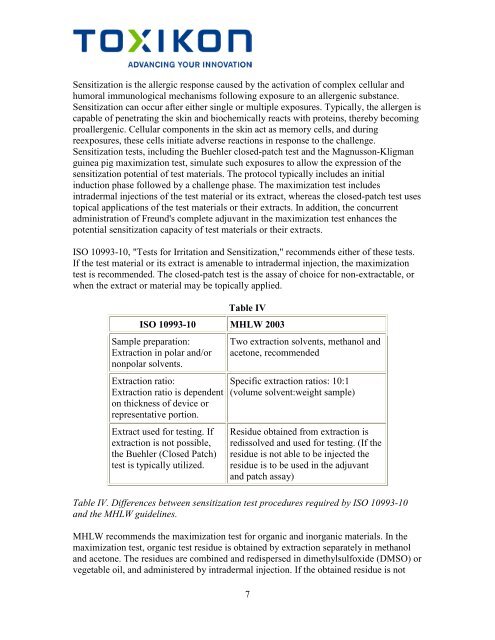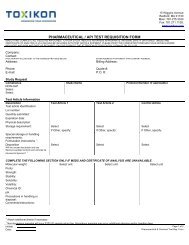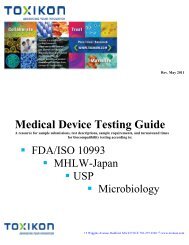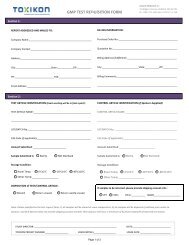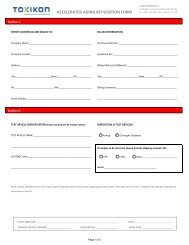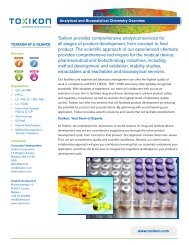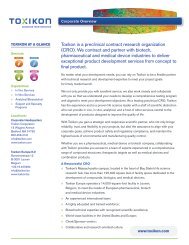Biocompatibility Safety Assessment of Medical Devices ... - Toxikon
Biocompatibility Safety Assessment of Medical Devices ... - Toxikon
Biocompatibility Safety Assessment of Medical Devices ... - Toxikon
You also want an ePaper? Increase the reach of your titles
YUMPU automatically turns print PDFs into web optimized ePapers that Google loves.
Sensitization is the allergic response caused by the activation <strong>of</strong> complex cellular and<br />
humoral immunological mechanisms following exposure to an allergenic substance.<br />
Sensitization can occur after either single or multiple exposures. Typically, the allergen is<br />
capable <strong>of</strong> penetrating the skin and biochemically reacts with proteins, thereby becoming<br />
proallergenic. Cellular components in the skin act as memory cells, and during<br />
reexposures, these cells initiate adverse reactions in response to the challenge.<br />
Sensitization tests, including the Buehler closed-patch test and the Magnusson-Kligman<br />
guinea pig maximization test, simulate such exposures to allow the expression <strong>of</strong> the<br />
sensitization potential <strong>of</strong> test materials. The protocol typically includes an initial<br />
induction phase followed by a challenge phase. The maximization test includes<br />
intradermal injections <strong>of</strong> the test material or its extract, whereas the closed-patch test uses<br />
topical applications <strong>of</strong> the test materials or their extracts. In addition, the concurrent<br />
administration <strong>of</strong> Freund's complete adjuvant in the maximization test enhances the<br />
potential sensitization capacity <strong>of</strong> test materials or their extracts.<br />
ISO 10993-10, "Tests for Irritation and Sensitization," recommends either <strong>of</strong> these tests.<br />
If the test material or its extract is amenable to intradermal injection, the maximization<br />
test is recommended. The closed-patch test is the assay <strong>of</strong> choice for non-extractable, or<br />
when the extract or material may be topically applied.<br />
Table IV<br />
ISO 10993-10 MHLW 2003<br />
Sample preparation:<br />
Extraction in polar and/or<br />
nonpolar solvents.<br />
Extraction ratio:<br />
Extraction ratio is dependent<br />
on thickness <strong>of</strong> device or<br />
representative portion.<br />
Extract used for testing. If<br />
extraction is not possible,<br />
the Buehler (Closed Patch)<br />
test is typically utilized.<br />
Two extraction solvents, methanol and<br />
acetone, recommended<br />
Specific extraction ratios: 10:1<br />
(volume solvent:weight sample)<br />
Residue obtained from extraction is<br />
redissolved and used for testing. (If the<br />
residue is not able to be injected the<br />
residue is to be used in the adjuvant<br />
and patch assay)<br />
Table IV. Differences between sensitization test procedures required by ISO 10993-10<br />
and the MHLW guidelines.<br />
MHLW recommends the maximization test for organic and inorganic materials. In the<br />
maximization test, organic test residue is obtained by extraction separately in methanol<br />
and acetone. The residues are combined and redispersed in dimethylsulfoxide (DMSO) or<br />
vegetable oil, and administered by intradermal injection. If the obtained residue is not<br />
7


